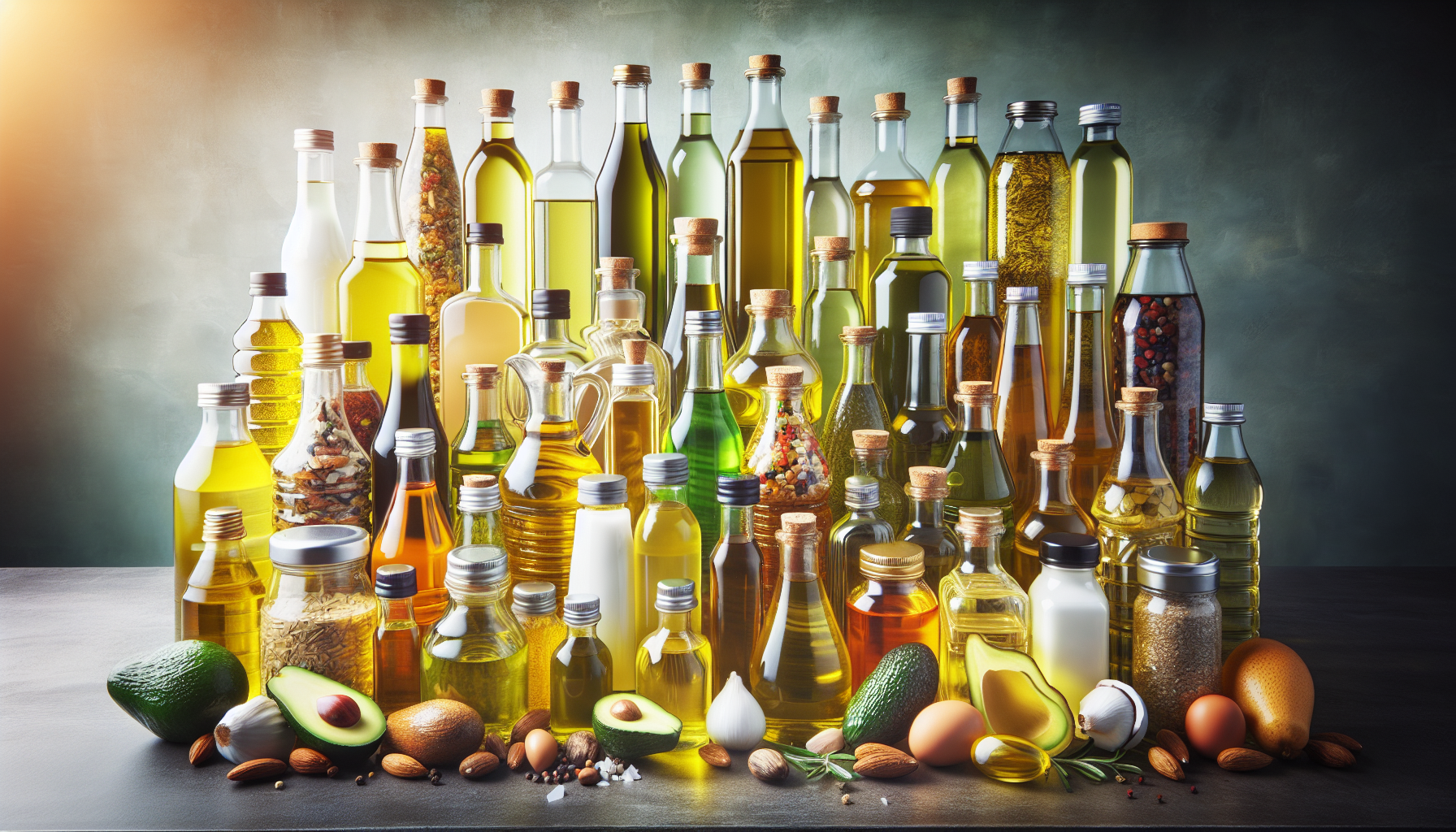Are you looking to prioritize your well-being while still enjoying delicious meals? Look no further than Tastepan’s collection of nutritious recipes and expert advice. With a focus on healthy eating, Tastepan offers a wide variety of wholesome meal ideas and dietary tips that will nourish your body without sacrificing flavor. One important aspect of cooking healthily is choosing the right oils for your recipes. In this article, we will guide you through the process of selecting the best oils for cooking, ensuring that you make the most nutritious choices in the kitchen.

Understanding Healthy Oils
When it comes to cooking, using healthy oils is essential. Not only do they add flavor to your dishes, but they also provide numerous health benefits. However, with so many options available, it can be overwhelming to understand which oils are actually healthy. In this article, we will explore the different types of healthy oils, their benefits, and their smoke points to help you make informed choices in your kitchen.
Types of healthy oils
There are several types of healthy oils that are commonly used in cooking. These include olive oil, coconut oil, avocado oil, canola oil, and grapeseed oil. Each oil has its own unique characteristics and nutritional profile, making them suitable for various cooking methods and flavor preferences.
Benefits of using healthy oils
Using healthy oils in your cooking not only enhances the flavor of your dishes but also offers a range of health benefits. Healthy oils are rich in essential fatty acids, which are important for maintaining healthy skin, supporting brain function, and reducing the risk of chronic diseases. Additionally, these oils contain antioxidants that help fight inflammation in the body and protect against oxidative stress. Using healthy oils can also improve your heart health by reducing bad cholesterol levels and promoting the production of good cholesterol.
Smoke points of healthy oils
The smoke point of an oil refers to the temperature at which it starts to smoke and break down. When oils reach their smoke point, they can release harmful compounds and lose their nutritional value. It is important to choose oils with smoke points that are suitable for the cooking method you plan to use. Using oils with low smoke points for high-heat cooking can result in the production of harmful free radicals. Understanding the smoke points of healthy oils will help you determine which oil to use for various cooking techniques.
Factors to Consider When Choosing Healthy Oils
When choosing healthy oils for your cooking, it is important to consider several factors to ensure you make the best choice. These factors include cooking temperature, flavor profile, nutritional content, processing methods, and storage stability.
Cooking temperature
The cooking temperature plays a crucial role in determining which oil is best suited for a particular dish. Certain oils, such as coconut oil and grapeseed oil, have high smoke points, making them ideal for high-heat cooking methods like frying and sautéing. On the other hand, oils with lower smoke points, such as olive oil and avocado oil, are better suited for low-heat cooking methods like baking and dressings.
Flavor profile
The flavor profile of an oil can greatly impact the taste of your dishes. Some oils, like olive oil, have a distinct flavor that can enhance the overall taste of Mediterranean-inspired dishes. On the other hand, oils like canola oil and grapeseed oil have more neutral flavors, making them versatile options for a wide range of cuisines. Consider the flavor profile of each oil and how it will complement the flavors in your dish when making your selection.
Nutritional content
When it comes to the nutritional content of oils, it is important to pay attention to the types of fats they contain. Healthy oils are typically high in monounsaturated fats and low in saturated fats and trans fats. These types of fats can help reduce bad cholesterol levels and promote heart health. Additionally, some oils, like coconut oil, contain medium-chain triglycerides (MCTs), which are easily digestible and can provide a quick source of energy.
Processing methods
The processing methods used to extract and refine oils can impact their nutritional quality. Cold-pressed oils are extracted without the use of heat or chemicals, which helps retain the natural flavor and nutrients of the oil. On the other hand, refined oils go through a more extensive processing method that involves heat and the use of solvents. While refined oils may have a higher smoke point, they may also have a reduced nutritional profile compared to their unrefined counterparts.
Storage stability
The stability of an oil during storage is an important factor to consider. Oils that are high in polyunsaturated fats, such as grapeseed oil, are more prone to oxidation and rancidity. Look for oils that come in dark, opaque bottles or containers to protect them from light exposure, which can accelerate oxidation. Storing oils in a cool, dark place can also help prolong their shelf life and maintain their quality.

Top Healthy Oils for Cooking
Now that we understand the factors to consider when choosing healthy oils, let’s explore some of the top options for cooking.
Olive oil
Olive oil is often hailed as the king of healthy oils due to its numerous health benefits and versatile uses in the kitchen. There are different types of olive oil available, including extra virgin, virgin, and light or pure olive oil.
Extra virgin olive oil
Extra virgin olive oil is the highest quality olive oil, obtained through cold-pressing olives without the use of heat or chemicals. It has a rich flavor and aroma, making it perfect for drizzling over salads and using in dips and dressings. Extra virgin olive oil has a low to medium smoke point, making it suitable for gentle cooking methods like sautéing and baking.
Virgin olive oil
Virgin olive oil is also obtained through cold-pressing olives, but it has a slightly higher acidity level than extra virgin olive oil. It has a milder flavor compared to extra virgin olive oil and a slightly higher smoke point, making it suitable for a wider range of cooking methods.
Light or pure olive oil
Light or pure olive oil is a refined oil that undergoes a more extensive processing method to remove impurities and neutralize the flavor. It has a higher smoke point, making it a good option for high-heat cooking methods like frying and roasting. However, it may have a reduced nutritional profile compared to extra virgin and virgin olive oil.
Coconut oil
Coconut oil has gained popularity in recent years due to its unique flavor and potential health benefits. It is solid at room temperature but melts quickly when heated. There are two main types of coconut oil: unrefined and refined.
Unrefined coconut oil
Unrefined coconut oil, often labeled as virgin or extra virgin, is extracted from fresh coconut meat without the use of heat or chemicals. It retains the natural flavor and aroma of coconuts, making it a great choice for adding a tropical twist to both sweet and savory dishes. Unrefined coconut oil has a medium to high smoke point, making it suitable for cooking at moderate temperatures.
Refined coconut oil
Refined coconut oil undergoes a more extensive processing method that involves heat and the use of solvents to remove impurities and neutralize the flavor. This results in a refined oil with a higher smoke point, making it suitable for high-heat cooking methods. However, refined coconut oil may have a slightly reduced nutritional profile compared to unrefined coconut oil.
Avocado oil
Avocado oil is a rich source of monounsaturated fats, which are beneficial for heart health. It has a mild, buttery flavor that complements a wide range of dishes. There are two main types of avocado oil: cold-pressed and refined.
Cold-pressed avocado oil
Cold-pressed avocado oil is extracted without the use of heat or chemicals, helping to retain its natural flavor and nutritional content. It has a medium smoke point, making it suitable for sautéing, baking, and dressings.
Refined avocado oil
Refined avocado oil undergoes a more extensive processing method that involves heat and the use of solvents. It has a higher smoke point, making it suitable for high-heat cooking methods like frying and grilling. However, refined avocado oil may have a slightly reduced nutritional profile compared to cold-pressed avocado oil.
Canola oil
Canola oil is a commonly used and heart-healthy option for cooking. It is low in saturated fat and high in monounsaturated fats, making it a good choice for maintaining heart health. There are two main types of canola oil: cold-pressed and refined.
Cold-pressed canola oil
Cold-pressed canola oil is extracted without the use of heat or chemicals, retaining the natural flavor and nutrients of the oil. It has a medium smoke point, making it suitable for sautéing, baking, and dressings.
Refined canola oil
Refined canola oil undergoes a more extensive processing method that involves heat and the use of solvents. It has a higher smoke point, making it suitable for high-heat cooking methods like frying and roasting. Refined canola oil has a more neutral flavor compared to cold-pressed canola oil.
Grapeseed oil
Grapeseed oil is a light and neutral oil that is extracted from the seeds of grapes. It has a high smoke point, making it suitable for high-heat cooking methods like frying and grilling. Grapeseed oil is known for its mild flavor, making it a versatile option for both sweet and savory dishes.
Cold-pressed grapeseed oil
Cold-pressed grapeseed oil is extracted without the use of heat or chemicals, helping to retain its natural flavor and nutritional content. It has a medium to high smoke point, making it suitable for a wide range of cooking methods.
Refined grapeseed oil
Refined grapeseed oil undergoes a more extensive processing method that involves heat and the use of solvents. It has a higher smoke point, making it suitable for high-heat cooking methods. Refined grapeseed oil has a more neutral flavor compared to cold-pressed grapeseed oil.
Cooking Tips for Using Healthy Oils
To make the most of your healthy oils in the kitchen, here are some cooking tips to keep in mind:
Proper storage of healthy oils
To ensure the longevity and quality of your healthy oils, it is important to store them properly. Oils should be stored in a cool, dark place away from direct sunlight, as exposure to light can accelerate oxidation. It is also important to keep the oils tightly sealed to prevent air from getting in, as air can also lead to oxidation and rancidity. Additionally, be mindful of the expiration dates on the oil bottles and use them before they expire to ensure the best flavor and nutritional value.
Using the right oil for different cooking methods
Each oil has its own smoke point, which determines its suitability for different cooking methods. It is important to use the right oil for the specific cooking technique you plan to employ. Oils with lower smoke points, like olive oil and avocado oil, are best suited for low-heat cooking methods such as baking and dressings. Oils with higher smoke points, like coconut oil and grapeseed oil, are better suited for high-heat cooking methods like frying and grilling. Using oils with appropriate smoke points will help you achieve the best results in your cooking.
Avoiding overheating and smoke points
Heating oils beyond their smoke point can lead to the production of harmful free radicals and the breakdown of their nutritional components. It is important to pay attention to the temperature of the oil while cooking and avoid overheating it. If you notice smoke or a strong smell coming from the oil, it is an indication that it has reached its smoke point and should be discarded. To prevent overheating, it is recommended to use a cooking thermometer to monitor the temperature of the oil.

Conclusion
In conclusion, using healthy oils in your cooking can greatly enhance the flavor of your dishes while providing several health benefits. Understanding the different types of healthy oils, their benefits, and their smoke points is essential for making informed choices in your kitchen. Factors such as cooking temperature, flavor profile, nutritional content, processing methods, and storage stability should be considered when selecting oils for your cooking needs. By using the right oil for different cooking methods, proper storage techniques, and being mindful of smoke points, you can make the most of your healthy oils and create delicious and nutritious meals. Prioritize your well-being by incorporating these healthy oils into your cooking routine and enjoy the benefits they bring to your overall health.

